
Dungkar Monastery
The 7th Domo Geshe Rinpoche Ngawang Kalsang was so highly respected that upon meeting him, the 13th Dalai Lama declared that he had met Lama Tsongkhapa himself. There were many auspicious signs accompanying his birth and throughout his life, Domo Geshe received visions of various deities, starting with Vajrayogini who manifested before him when he was 4, to offer nourishment to him from the realm of the dakinis.
Throughout his life, Domo Geshe worked tirelessly to spread Lama Tsongkhapa’s tradition. He established monasteries in barren, barbaric places and even revived Buddhist practice in Bodhgaya. Of course, given his fame, many did not have the merits to rejoice in his good deeds and were jealous of his work. There were many attempts on Rinpoche’s life but he remained undaunted and unwavering in his bodhisattva motivation.
The line of Domo Geshe incarnations is said to include Shariputra, the Mahasiddha Gayadhara, Dharmashri, Munijnana, Thönmi Sambhota, King Trisong Detsen, Dromtönpa, Milarepa, Khedrup Rinpoche, and Tragpa Gyaltsen.
In his 8th incarnation, one of Domo Geshe Rinpoche’s greatest deeds was subduing a raging spirit who had arisen due to a Mongolian geshe’s untimely death. Calling him Namkar Barzin, Domo Geshe swore him to join DS in protecting the uncommon teachings of Nagarjuna, thus adding him to DS’s entourage.
We can see that throughout his incarnations, Domo Geshe Rinpoche has always been closely associated with Dorje Shugden as a master of the practice. He was also a heart son of Lama Tsongkhapa himself – can someone who inseparably sits alongside Je Rinpoche on altars worldwide really be so wrong and engage in spirit practice in his succeeding lifetimes?
We wish to share this biography with you so that you might rejoice in the great deeds of this living Buddha whose work to spread the Buddhadharma in Tibet was unparalleled. May many more masters of his calibre arise in this world in our lifetimes, to turn the Wheel of Dharma for the sake of all sentient beings. May we never be parted from such perfect teachers and always gain good rebirths so that we might receive the holy words of Buddha from them.
For more information about this great master, check out these links:
Famous Oracle of Dungkar Monastery
dorjeshugden.com/?p=307Did the 13th Dalai Lama Ban the Practice of Dorje Shugden?
dorjeshugden.com/?p=3811Mysterious white conch-shell in Dungkar Monastery
dorjeshugden.com/?p=11761A biography of glorious 7th and 8th incarnations of Kyabje Domo Geshe Rinpoche
dorjeshugden.com/?p=1315

All of us at DorjeShugden.com make this virtual offering of a butterlamp to the incomparable master His Eminence Kyabje Domo Geshe Rinpoche, requesting him to remain for another 1,000 years to continue turning the wheel of Dharma and benefiting countless beings.
Biography
Source: http://www.domogesherinpoche.org/
 Kyabje Domo Geshe Rinpoche Ngawang Kalsang, the legendary figure whose previous incarnations include Shariputra, the Mahadsiddha Gayadhara, Dharmashri, Munijnana, Tönmi Sambhota, King Trisong Detzen, Dromtönpa, Milarepa, Khedrup Rinpoche, and Dragpa Gyaltsen, was known throughout Tibet and the Himalayan region for his immense kindness, humility, great deeds, and non-sectarian attitude. He spread the pure teachings of the Buddha throughout the Himalayas from Kashmir to Assam, and in the process he established the first Gelugpa monasteries in regions where there had been none.
Kyabje Domo Geshe Rinpoche Ngawang Kalsang, the legendary figure whose previous incarnations include Shariputra, the Mahadsiddha Gayadhara, Dharmashri, Munijnana, Tönmi Sambhota, King Trisong Detzen, Dromtönpa, Milarepa, Khedrup Rinpoche, and Dragpa Gyaltsen, was known throughout Tibet and the Himalayan region for his immense kindness, humility, great deeds, and non-sectarian attitude. He spread the pure teachings of the Buddha throughout the Himalayas from Kashmir to Assam, and in the process he established the first Gelugpa monasteries in regions where there had been none.
Domo Geshe Rinpoche was also famous because he was the first of the Tibetan lamas to go on pilgrimage repeatedly to the Buddhist holy sites in India, when this was not yet an established tradition. Active in the Tsang and central parts of Tibet, he was openly praised by both the Panchen Rinpoche and His Holiness the Thirteenth Dalai Lama, who referred to him as a “realized one who is completely tamed” and as someone who is “Lama to people inside and outside of Tibet and whose widespread fame resonates like the sound of a great bell.” In fact, his fame extends to Mongolia, China, Japan, India, Sri Lanka, and many Western countries.
Nearly all written biographical information about Geshe Ngawang Kalsang, who later became known as Domo Geshe Rinpoche, was lost in Tibet. However there does exist the lineage prayer composed by Kyabje Trijang Dorje Chang; biographical material mentioned by the Western disciple Lama Govinda in his book The Way of the White Clouds; and many diverse oral sources. From these it is known that Ngawang Kalsang was born in 1866 in Emagang, Tsang, Tibet.
At the age of eight he entered Tashi Lhunpo Monastery and was given the name Ngawang Kalsang by the Panchen Rinpoche Tenpa’i Wangchuk. He took full ordination from the incarnation of the great translator Lochen Rinchen Zangpo Rinpoche. After twenty years of study he received the “Kachen” degree, which was Tashi Lhunpo’s equivalent of the “Geshe” degree of Central Tibet’s great monastic universities.
After finding his root Guru, Rangjung Lama Lobsang Zöpa, Geshe Ngawang Kalsang spent many years receiving teachings and initiations, making pilgrimages, and meditating in caves in Bhutan, Sikkim, and Tibet. In different holy places along the Himalayan snow mountain range, in caves and isolated places, Geshe Rinpoche practiced and actually saw the different meditational deities, receiving their blessings, teachings, guidance, and predictions.
When the Guru conferred upon him the great empowerment of the five-deity Heruka Chakrasamvara mandala of the Ghantapada tradition (Demchog Trilbu Lha-nga) in Milarepa’s temple at Lapchi, the mandala and deity actually manifested and entrusted him with the future of the Demchog tantra. During his retreats Geshe Ngawang Kalsang lived on fruits, berries, and herbs, and also was sustained by the practice of “taking the essence” of flowers and stones. It is said that while he was meditating in a remote cave in the dense forests of Upper Tromo, yeti came to serve him by bringing him firewood and water.
While Geshe Ngawang Kalsang was meditating in the cave in Upper Tromo (also called Domo, Tomo, or Chumbi), a nomad who was searching for some of his lost animals came upon him. Hardly believing that anyone could survive in such a remote place, the nomad offered him yogurt and milk. It was then that Geshe Ngawang Kalsang left his solitary retreat and began performing the renowned deeds which made his name famous throughout the Himalayas.
First, he fulfilled a prophecy made by both his Guru and by Dromtönpa, the main disciple of Atisha Dipamkara, by erecting a large Maitreya Buddha statue at Galingkang. When the people of Tromo requested Geshe Ngawang Kalsang to remain with them, he rebuilt and revitalized Dungkar Gonpa, the White Conch Monastery, which was in the Tromo valley. He erected a great Maitreya Buddha statue in the main hall of the monastery, expanded the monastic curriculum, improved discipline, and introduced the study of art forms such as dance that related to religious practice.
Domo Geshe Rinpoche also began a special Guru Rinpoche ritual which was performed at the monastery yearly. In another monastery in the Tromo Valley he instituted the annual practice of the joint reading of twelve collected works (sung bum) by monks of different religious traditions. In this way, among others, Domo Geshe Rinpoche helped bring the people of Tromo together in greater harmony.

H.H. the 13th Dalai Lama Thubten Gyatso
Under the direction of Domo Geshe Rinpoche the monastery became the seat of the famous and respected oracle that was consulted by people from all over Tibet. At the crossroads between India and Tibet, Dungkar Gonpa also became known as a stopping place for most Tibetan and foreign dignitaries who were on their way to and from Lhasa. Thus, Dungkar Gonpa was open to international contact in a way that was unusual for Tibet at that time.
When His Holiness the Thirteenth Dalai Lama returned from India in 1912 he stopped in Tromo, and a meeting took place between His Holiness and Domo Geshe Rinpoche at Kangyur Lhakang in Galingkang. One morning His Holiness mentioned to his attendants that he expected a very special visitor that afternoon.
That day Domo Geshe Rinpoche, who always looked like a simple monk, brought special delicacies to offer to His Holiness and spent a long time in private talks with him. In the evening, His Holiness asked his attendants if they had seen the very special person who had visited him in the afternoon. They said that they had only seen a monk in tattered robes. His Holiness replied, “That is too bad. I saw Je Tsong Khapa himself.”
Many years later, in the 1950s, the Dungkar Gonpa twice hosted His Holiness the Fourteenth Dalai Lama and his government for extended periods of time.
A very close and special relationship existed between Geshe Rinpoche and Kyabje Trijang Dorje Chang. Together they received teachings and initiations from Kyabje Pabongka Rinpoche, Lamrim teachings from His Holiness the Thirteenth Dalai Lama, and together with Kyabje Pabongka Rinpoche, in 1921 they received a very rare cycle of 108 initiations from Tagdra Dorje Chang, who later became the Regent of Tibet. The initiations spanned the four classes of Tantra, and Kyabje Trijang Rinpoche said of that event, “Thus, the traditions of past successive lineages were observed correctly without the negligence of finding easy solutions.” (Kyabje Trijang Rinpoche, Autobiography, p. 94.)
Domo Geshe Rinpoche was one of the first Tibetan lamas to go on repeated pilgrimages to the holy places of the Buddha in India. At first he went alone across the high mountain passes from Tromo to Sikkim, through Pedong to Kalimpong, and then by train from Siliguri to Gaya. Later he took with him his monks and people from all walks of life. At that time Hindus controlled the great stupa at Bodh Gaya and Buddhist practice was not welcome there.
However, the Hindu Raja who was in charge was very impressed with Geshe Rinpoche and trusted him completely. The great stupa was usually locked up, but when Rinpoche visited the Raja handed him the keys and turned over the stupa to him for the duration of his stay. Only Domo Geshe Rinpoche and Sri Anagarika Dharmapala, founder of the Mahabodhi Society, represented Buddhist interests and regularly performed Buddhist practices at the stupa. It was only because of Domo Geshe Rinpoche’s help and influence that a Lhadaki monk could purchase ground near the stupa to build a Tibetan monastery.
During their pilgrimages to Bodh Gaya, Geshe Rinpoche’s disciples cleaned the area around the stupa, washed the Bodhi tree with purifying water, and offered many butter lamps and other offerings. On the full moon of the eighth Tibetan month in 1916, Domo Geshe Rinpoche performed the ritual bath offering using milk to bathe the statue of Shakyamuni Buddha and then covered it with gold. The holy body of the Buddha emitted nectar, an event witnessed by many. Geshe Rinpoche carefully collected it and used it for the benefit of sentient beings in holy objects and rilbus.
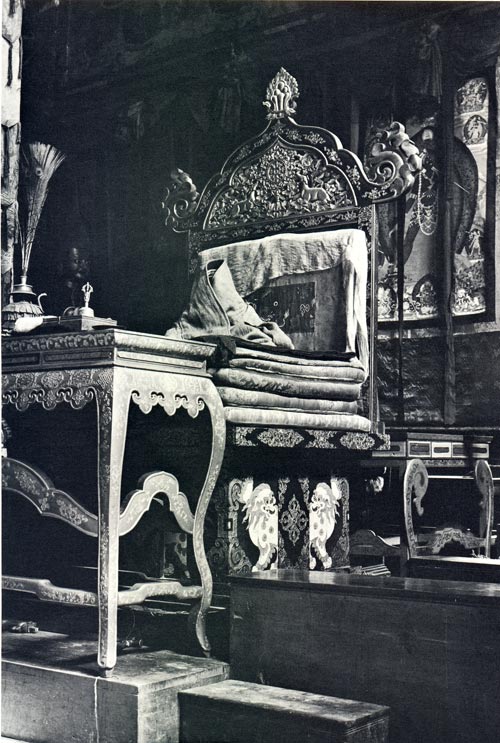
Domo Geshe Rinpoche’s throne in Dungkar Monastery
Domo Geshe Rinpoche’s rilbus were precious pills made from medicinal herbs, sacred relics, and many different holy substances that he collected in the Buddha’s hallowed places in India and in pilgrimages in the Himalayas and Tibet. The rilbus made by Domo Geshe Rinpoche were famous for their power. They were said to reverse the effects of life-threatening poison, to protect against many different kinds of weapons, and to guarantee at least seven human rebirths if administered at the right moment in the death process.
In the Indian Himalayan region, especially today’s Himachal Pradesh, Domo Geshe Rinpoche traveled widely, teaching the pure doctrine of the Buddha, establishing monasteries, gathering monks, and healing the sick. In fact, he was widely known as “the precious doctor of Chumbi.” In many areas he established Gelugpa monasteries and temples and everywhere he went he was requested to teach and to confer empowerments and Pratimoksha vows.
Upon the request of the King of Piti, Geshe Rinpoche gave Lamrim teachings to thousands of people, as well as conferring long-life and other empowerments. Domo Geshe Rinpoche is singularly credited, not only by his followers but by the Tibetan government as well, for having spread Je Tsong Khapa’s teachings, especially throughout the whole Himalayan region. Although he gave formal teachings, Domo Geshe Rinpoche taught most often by giving practical advice on what to do and what not to do. In all he did he laid the foundation for spiritual practice.
Domo Geshe Rinpoche’s disciple Lama Anagarika Govinda recorded in The Way of the White Clouds that Geshe Rinpoche “detested any kind of hero-worship and did not want his person made into an object of veneration.” On the day that Domo Geshe Rinpoche accepted him as a disciple his Guru told him:
“If you wish me to be your Guru, do not look upon my person as the Guru, because every human personality has its shortcomings, and so long as we are engaged in observing the imperfections of others we deprive ourselves of the opportunities of learning from them. Remember that every being carries within itself the spark of Buddahood (bodhicitta), but as long as we concentrate on other people’s faults we deprive ourselves of the light that in various degrees shines out from our fellow-beings ….The greatest among men were those who recognized the divine qualities in their fellow-beings and were always ready to respect even the lowliest among them.
As long as we regard ourselves superior to other or look down upon the world, we cannot make any real progress. As soon, however, as we understand that we live in exactly that world which we deserve, we shall recognize the faults of others as our own —though they may appear in different form. It is our own karma that we live in this “imperfect” world, which in the ultimate sense is our own creation. This is the only attitude which can help us to overcome our difficulties, because it replaces fruitless negation by an impulse towards self-perfection, which not only makes us worthy of a better world but partners in its creation.”
Because he was revered in India as well as Tibet, Domo Geshe Rinpoche was offered several monasteries in northern India. A patron from Darjeeling offered him a retreat house at Ghoom Yiga Chöling Monastery and requested him to take care of the monastery. Rinpoche enlarged it and built another famous two-storey Maitreya Buddha statue with the help of Wangyal, the same artist who had fashioned the ones in Tromo.
In 1919 Tashi Chöling Monastery in Kurseong, near Darjeeling, was completed and consecrated by Geshe Rinpoche, and Tharpa Chöling Monastery in Kalimpong was finished in 1922. This monastery had been built with the support of and requests from the Maharani of Bhutan, an influential Chinese merchant and his Tibetan wife, a group of Tibetans living in Kalimpong, and many other.
By the time Tharpa Chöling was completed, Dungkar Gonpa had already built or taken under its administrative umbrella several other monasteries in Tromo and Phari, Tibet. Until 1959 the Dungkar Gonpa monks took turns in administering these places, as well as the monasteries across the border in India. In addition, there were a number of small temples and chapels in the Himalayan border area offered to and consecrated by Domo Geshe Rinpoche.
Among many other accomplishments, Domo Geshe Rinpoche was famous for his extraordinary visions. The most well-known of his visions occurred on one of Geshe Rinpoche’s many pilgrimages. At nineteen thousand feet on the northern slopes of Kanchenjunga, Chorten Nyima has been a very special holy place since at least the time of Padma Sambhava. There Domo Geshe Rinpoche manifested a vision for all within a radius of miles to see. First, from among the white clouds appeared a white horse leading the procession that moved from east to west. Then from the dark blue sky a great number of Buddhas, Bodhisattvas, and different holy beings and signs appeared, all made from light and rainbows.
Only Domo Geshe Rinpoche saw the whole extent of the vision, while those in his retinue saw parts according to individual capacity and karma. Some saw Khedrup Rinpoche’s five visions of Je Tsong Khapa; some saw Je Tsong Khapa and his two main disciples, while other saw the Medicine Buddha, Amitayus, or different pure lands. Everyone could see the eight auspicious signs. The vision remained for a long time, so Rinpoche’s disciples could point out to each other in minutest detail what they saw.
The only other vision of that magnitude made public in the same way occurred at the time of Shakyamuni Buddha, an account of which can be found in the Surangama Sutra. After the eyewitnesses returned to Dungkar Gonpa each of them described what they had seen, and from these descriptions a fresco recording the event was carefully painted.
Those who knew him said that Domo Geshe Rinpoche was genuinely humble and completely without pride of thinking that he knew anything. No photograph exists of him. He did not allow anyone to take a photograph of him, because, in those days, photographs were taken mostly of famous people such as heads of state or those with a high social status. When pictures were taken without his permission, Geshe Rinpoche was either not visible or blurred beyond recognition. The only likeness that existed was a statue fashioned after the preserved body that was placed in his stupa.
After Domo Geshe Rinpoche Ngawang Kalsang passed away in 1936, the Dungkar Gonpa administration requested the central Tibetan government for permission to embalm his body. Although only the bodies of the Dalai Lamas and the Panchen Lamas were customarily embalmed and sealed in large stupas, the request was granted. The Regent Reting Rinpoche’s decree read, “In Southern Tibet, including Sikkim, etc., Domo Geshe Rinpoche’s activities were exactly like those of Je Tsong Khapa. In accordance, we will allow Rinpoche’s body to be preserved.” The holy stupa was consecrated in 1938 by Kyabje Trijang Rinpoche Dorje Chang and remained an object of veneration until it, along with the entire Dungkar Gonpa, was destroyed in the Cultural Revolution.
All quoted material has been extracted from His Holiness Domo Geshe Rinpoche, A Biographical Sketch, by Dr. Ursula Bernis, copyright ©2002 by the Dungkar Gonpa Society.
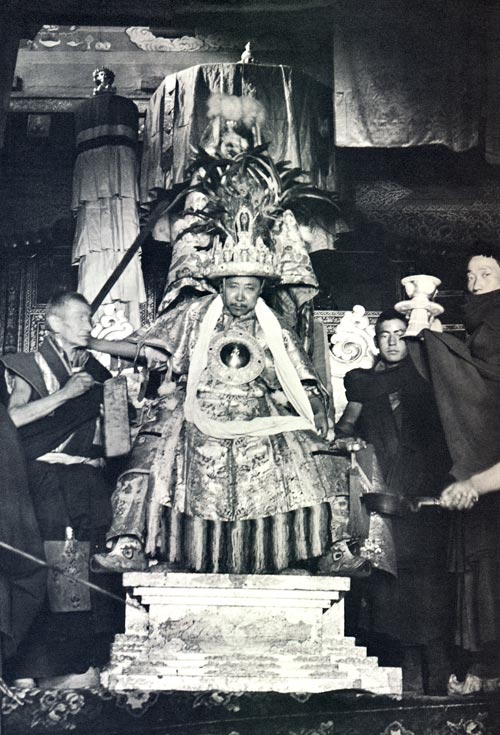
The oracle of Dungkar Monastery taking trance of Dorje Shugden (wrathful form) (photo taken between 1947-1949)
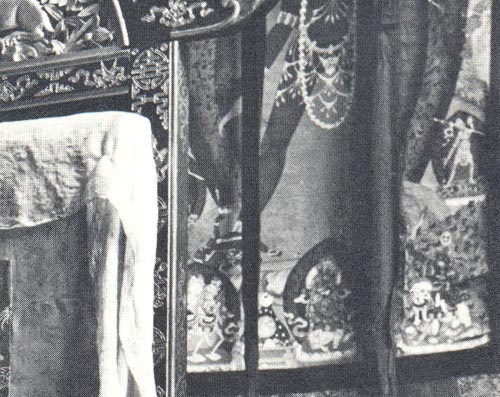
Thangka behind Domo Geshe Rinpoche’s throne at Dungkar Monastery showing Dorje Shugden as one of the protectors (bottom right corner)
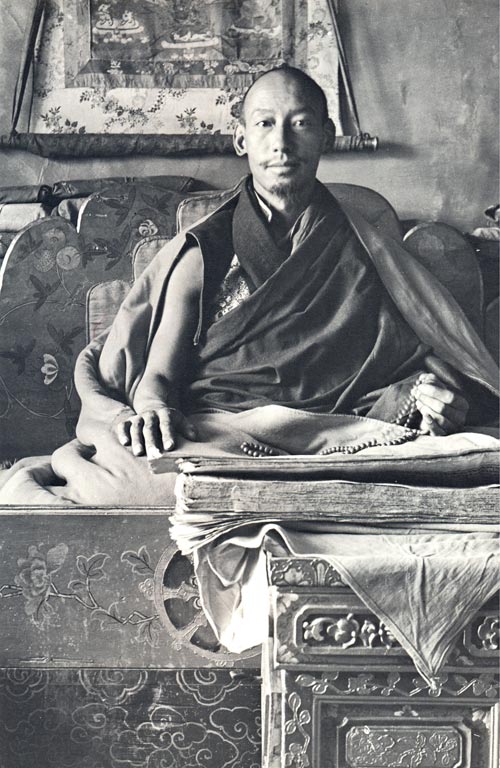
Zong Rinpoche at a branch monastery of Rizong Pordoh at Phari Dzong
(photo taken between 1947-1949)
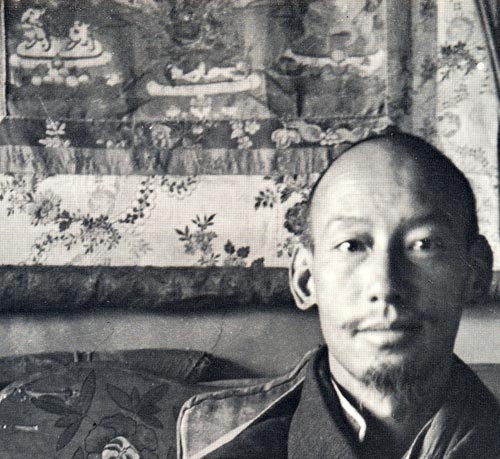
Thangka behind Zong Rinpoche showing Dorje Shugden as one of the protectors (top left corner)








































 English
English Indonesia
Indonesia Tibetan
Tibetan
Agnes Kohl
April 15, 2012
“If you wish me to be your Guru, do not look upon my person as the Guru, because every human personality has its shortcomings, and so long as we are engaged in observing the imperfections of others we deprive ourselves of the opportunities of learning from them. Remember that every being carries within itself the spark of Buddahood (bodhicitta), but as long as we concentrate on other people’s faults we deprive ourselves of the light that in various degrees shines out from our fellow-beings ….The greatest among men were those who recognized the divine qualities in their fellow-beings and were always ready to respect even the lowliest among them.
As long as we regard ourselves superior to other or look down upon the world, we cannot make any real progress. As soon, however, as we understand that we live in exactly that world which we deserve, we shall recognize the faults of others as our own —though they may appear in different form. It is our own karma that we live in this “imperfect” world, which in the ultimate sense is our own creation. This is the only attitude which can help us to overcome our difficulties, because it replaces fruitless negation by an impulse towards self-perfection, which not only makes us worthy of a better world but partners in its creation.”
This quote is what stuck our for me from this whole tribute. It is such a deep and profound teaching that should everyone practice such, irregardless of religion, culture and race, much if not all suffering will vanish. There will be true peace and happiness in this world. However it is sad that many cannot practice non-judgement and indulge in being right or carelessness with people. It is no wonder that we still have suffering which is all man-made.
After reading this tribute, I am AGAIN convinced that if such Great Masters practiced Dorje Shugden, how could it be wrong and further negates the Ban. The 14th HHDL even spent time in Dome Yeshe Rinpoche’s monastery! Basically, if such great masters practiced, then it does not take a brilliant scientist to recognise how illogical is the Ban. The Ban is completely a farce.
Diamond Girl
April 29, 2012
The mindstream remains the same even when the physical body changes form. This is very clear and evidential when one studies and observes current recognised Lamas and their previous lives. In this instance of Domo Geshe Rinpoche, I request that you all also read this link here which tells you of auspicious signs during the ordination of the current recognized Domo Geshe Rinpoche which took place this year!
Amazing!
http://dorjeshugden.com/wp/?p=11761&cpage=1#comment-25727
Miracle around Domo Geshe Rinpoche
Icy
May 5, 2012
Reading the biography of enlightened beings and learning their enlightened qualities are incredibly inspirational. It creates virtuous imprints in our mind stream and plant the seed of enlightenment. Enlightened Beings like Domo Geshe Rinpoche who out of great compassion returns life after life to immensely benefit beings is profoundly moving. No wonder the Dalai Lama exclaimed he saw in Domo Geshe Rinpoche Lama Tsongkhapa for he is already one with Lama Tsongkhapa.
I am certainly thrilled that his young incarnation is presently studying at Shar Gaden Monastery to carry on the lineage.
SabrinaS
June 15, 2016
Domo Geshe Rinpoche was indeed enlightened as proven by his incredible dharmic activities. Even the 13th Dalai Lama had recognised him as Lama Tsongkapa and he was accorded the “customarily embalmed and sealed in large stupas” upon his passing into clear light, which only the Dalai Lamas and Panchen Lamas are allowed for. “The Regent Reting Rinpoche’s decree read, “In Southern Tibet, including Sikkim, etc., Domo Geshe Rinpoche’s activities were exactly like those of Je Tsong Khapa. In accordance, we will allow Rinpoche’s body to be preserved.”
As such, Domo Geshe Rinpoche’s attainments and enlightenment are indisputable. Therefore whatever he had been practising should not also be disputed as with his enlightened mind, he would know if the practise is beneficial or not. Then it goes to say that the practise of Protector Dorje Shugden which he propitiates should be undisputed as an enlightened Protector and beneficial to practitioners. Could his enlightened mind be “tricked” by Dorje Shugden, claimed by the 14th Dalai Lama and CTA as an “evil spirit”? I definitely think not. Besides, Domo Geshe Rinpoche has been reincarnated and not have to “go to Hell” as claimed will befall all Dorje Shugden practitioners. Such utter nonsense that can so easily be disputed.
It is amazing and inspiring to read of the greatness of all attained Gurus and how their activities only bring the dharma to the people wherever to go. In their compassion, they work so tirelessly to bring people the blessings of Buddha. May more great Lamas arise to lift us out of our ignorance.
Vajrayogini
April 9, 2019
Dorie shugden is one with je tsongkarpa who is an emanation of manjushri. When we make requests to him we are automatically requesting manjushri to bestow his wisdom on us. Manjushri manifests in different forms but we can be sure Dorie shugden is one with him
Camilia
July 4, 2016
As I was reading the article, these 2 paragraphs caught my attention:
“If you wish me to be your Guru, do not look upon my person as the Guru, because every human personality has its shortcomings, and so long as we are engaged in observing the imperfections of others we deprive ourselves of the opportunities of learning from them. Remember that every being carries within itself the spark of Buddahood (bodhicitta), but as long as we concentrate on other people’s faults we deprive ourselves of the light that in various degrees shines out from our fellow-beings ….The greatest among men were those who recognized the divine qualities in their fellow-beings and were always ready to respect even the lowliest among them.
As long as we regard ourselves superior to other or look down upon the world, we cannot make any real progress. As soon, however, as we understand that we live in exactly that world which we deserve, we shall recognize the faults of others as our own —though they may appear in different form. It is our own karma that we live in this “imperfect” world, which in the ultimate sense is our own creation. This is the only attitude which can help us to overcome our difficulties, because it replaces fruitless negation by an impulse towards self-perfection, which not only makes us worthy of a better world but partners in its creation.”
Very aptly pronouncing the mindset of mundane beings, i.e. people like me. It reminds me of the 8 verses of mind transformation originally written by Shantideva who then passed down through a line of traceable lineage masters.
Eight Verses of Thought Transformation
With the thought of attaining Enlightenment
For the welfare of all beings,
Who are more precious than a wish–fulfilling jewel,
I will constantly practise holding them dear.
Whenever I am with others,
I will practise seeing myself as the lowest of all,
And from the very depths of my heart
I will respectfully hold others as supreme.
In all actions I will examine my mind
And the moment a disturbing attitude arises,
Endangering myself or others,
I will firmly confront and avert it.
Whenever I meet a person of bad nature,
Overwhelmed by negative energy and intense suffering,
I will hold such a rare one dear
As if I’ve found a precious treasure.
When others out of jealousy,
Mistreat me with abuse, slander and so on,
I will practise accepting defeat
And offering the victory to them.
When someone I have benefited and in whom
I have placed great trust hurts me very badly,
I will practise seeing that person
As my supreme teacher.
In short, I will offer directly and indirectly
Every benefit and happiness to all beings, my mothers.
I will practise in secret taking upon myself
All their harmful actions and sufferings.
Without these practices being defiled
By the stains of the eight worldly concerns,
By perceiving all phenomena as illusory,
I will practise without grasping to release all beings
From the bondage of the disturbing unsubdued mind and karma.